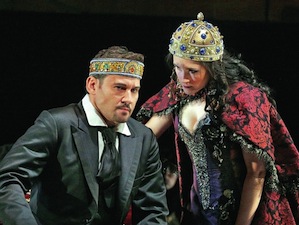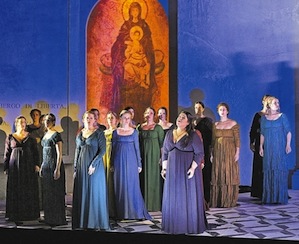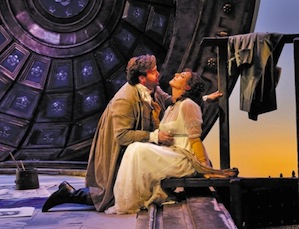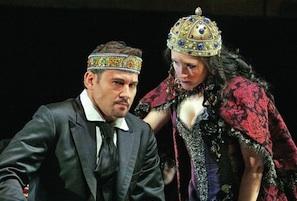
Photos by Ken Howard
Hard times have forced many opera companies to retreat into the tried and true. But opera lovers in search of rarities might consider heading to Santa Fe this month, where the Santa Fe Opera is featuring two first-rate productions of works that usually reside on the fringe. Setting the gold standard is the company’s first production of Karol Szymanowski’s King Roger, with the charismatic Polish baritone Marius Kwiecien in the title role. Joining Szymanowski’s early 20th-century masterpiece is Rossini’s Maometto II, presented in a new critical edition and featuring a dynamic cast. Playing in repertory with Bizet’s The Pearl Fishers, Puccini’s Tosca, and Richard Strauss’ Arabella, performances continue through August 25.
King Roger (reviewed July 21) achieves a particularly sublime synthesis of musical potency, vocal assurance, and telling design. Szymanowski’s 1926 Symbolist opera may never acquire wide repertory status — only in the last three decades has the work been performed in major houses — yet this production argued persuasively for its merits. The composer and his colibrettist, Jaroslaw Iwaszkiewicz, recount the story of King Roger, a Byzantine ruler in medieval Sicily whose comfortable world is upended by the arrival of a mysterious Shepherd. Preaching a hedonistic gospel of love, nature, and personal freedom, the newcomer frightens the king —is the Shepherd a messiah, or a hostile force? — but he quickly converts Roger’s courtiers. Even the king’s wife, Queen Roxana, succumbs to his charms. After an ecstatic love-in, the Shepherd leads his new flock, including the besotted Roxana, into the forest. Roger follows, Lear-like: lost, bereft, and reduced to begging, but finally purified.
Szymanowski’s score is a marvel. Radiantly Romantic, mesmerizing, and explosive, it alternately suggests the luminous mysticism of Debussy’s Pelleas and Melisande and the raw power of Berg’s Wozzeck. Its archaic choral effusions and complex modern harmonies yield a variety of textures, but the composer often treats the orchestra as a single vast instrument. Evan Rogister, a young American conductor making his Santa Fe debut, summoned the opera’s sound world in spellbinding waves. Rogister kept the tension high throughout, and the well-tuned, responsive orchestra sounded gorgeous.
Szymanowski’s score is a marvel: radiantly Romantic, mesmerizing, and explosive.
Placed in the capable hands of director Stephen Wadsworth, the 90-minute production, performed without intermission, was splendid. Wadsworth and designers Thomas Lynch (sets) and Duane Schuler (lighting) evoked a somber atmosphere in the Mass that opens Act 1 and a starkly framed forest scene in Act 3. Resisting cliche, the director gave us an Act 2 bacchanal that was both elegant and arresting, with the courtiers shedding their inhibitions (and their outer garments) in an ecstatic reverie (costumes by Ann Hould-Ward, choreography by Peggy Hickey.)
Santa Fe Opera Cast Radiates Brilliance

The cast was magnificent. Kwiecien gave a brilliant performance in the title role, shaping the character of the anguished monarch with brooding intensity and deploying his attractive baritone with strength, clarity, and inward majesty. Tenor William Burden imparted zest and vibrancy to the Shepherd’s role. Soprano Erin Morley’s Roxana delivered her Act 2 aria with ravishing sensuality, and tenor Dennis Petersen sang with warmth as Roger’s advisor, Edrisi. Raymond Aceto’s Archbishop and Laura Wilde’s Deaconess made fine contributions.
Maometto II (July 18) also emerged triumphant. Rossini’s opera, about the Venetians of Negroponte under siege by the Turkish sultan Maometto, isn’t produced with the frequency of the composer’s better-known works, though its score — which runs nearly four hours in length — is filled with beautiful, captivating music. Santa Fe’s production, employing the new critical edition by Philip Gossett, was both musically stunning and dramatically affecting. Director David Alden, employing sets and costumes by Jon Morrell, set Act 1 in a crumbling Venetian city of curved marble walls (a quote from Plutarch was emblazoned on a prominent space). A huge red wedge bisected the stage in Act 2’s scene in Maometto’s camp; Schuler’s designs, evocative throughout, bathed the Act 3 tomb of Anna’s mother in light.
Rossini's 1820 score obviously exerted a powerful influence on Verdi. So, too, do the opera’s themes of love and duty, honor and betrayal. Maometto II recounts history, but the drama derives from an ill-fated love match: the Venetian leader, Erisso, wants his daughter, Anna, to marry Calbo. But Anna loves Maometto — her father’s sworn enemy.
Maometto’s title role is long and demanding, and bass-baritone Luca Pisaroni, in his role debut, rose to the occasion with ringing grandeur; unflagging in energy and unerring in precision, this was a heroic assumption. Soprano Leah Crocetto (also a role debut) limned Anna with stellar vocalism and dramatic urgency. Her voice — large, lustrous, and flexible — is a thing of beauty, strong and penetrating at the top of her range without ever losing warmth and focus. (This won’t come as a surprise to local audiences, who followed Crocetto over the last three years as an Adler fellow with San Francisco Opera. But this assignment offered further evidence that Crocetto is at the start of a major career.)
The cast was magnificent. Marius Kwiecien gave a brilliant performance in the title role, shaping the character of the anguished monarch with brooding intensity.
Tenor Bruce Sledge conferred nobility on the role of Erisso. In the trouser role of Calbo, Patricia Bardon projected a penetrating mezzo that turned harsh and edgy at the top. Matthew Newlin’s Condulmiero and Michael Dailey’s Selimo sang handsomely. Each character had moments of beauty, but Maometto achieves greatness in Rossini’s trios, sung with elegant line by Pisaroni, Crocetto, and Sledge. The chorus covered itself in glory, and Santa Fe chief conductor Frédéric Chaslin led a compelling performance.
A Tosca Tipped Sideways

I wasn’t able to see Arabella or The Pearl Fishers, but I did attend a performance of Tosca (July 20.) If Stephen Barlow’s production didn’t boast the same kind of intelligent staging, it still benefited from Chaslin’s keen music direction and a strong, youthful cast. As Puccini’s heroine, soprano Amanda Echalaz wasn’t entirely satisfying. The notes are there, and the voice is large and well-supported. But Echalaz misses the vocal color, and the dramatic urgency, of the great Toscas; “Vissi d’arte” emerged largely shorn of passion. Brian Jagde, an 11th-hour replacement for the originally scheduled Andrew Richards, fared better as Cavaradossi. In his first outing as the painter/revolutionary, Jagde still seemed to be settling into the role — his Act 1 was a bit hesitant — but the tenor’s clarion tone, assertive deportment, and a suave “E lucevan le stelle” suggested that Cavaradossi will be a very good fit for him (he’s scheduled for San Francisco Opera’s Tosca this fall). Bass Raymond Aceto was not a terribly menacing Scarpia, though his musical intelligence is always an asset, and his take on the role — a petty tyrant who thoroughly enjoys wielding power — proved convincing. Zachary Nelson (Angelotti), Dale Travis (Sacristan), Dennis Petersen (Spoletta), and Christian Bowers (Sciarrone) performed well in subsidiary roles.
This assignment offered further evidence that Leah Crocetto is at the start of a major career.
Barlow’s production literally turned this Tosca on its side; the Church of Sant’ Andrea della Valle was tipped so that the audience looked directly into its tower, and Cavaradossi’s mural became the church’s floor — an odd perspective, to be sure. But Chaslin made the big moments count: The Act 1 Te Deum exerted its customary power, and there were many fine details throughout the evening. The conductor shaped the score with a firm hand throughout, supplying the dramatic potency that was often missing in the individual performances.
August is a great month for music in Santa Fe. In addition to the opera, the 40th annual Santa Fe Chamber Music Festival is in full swing. (A few days after I saw Maometto, Pisaroni sang selections from Schubert’s Schwanengesang in a downtown recital.) Before the festival closes, on August 20, artists including Alan Gilbert, Jeremy Denk, Leila Josefowicz, Oliver Knussen, Magnus Lindberg, Joyce Yang, and the Orion Quartet will appear in a wide variety of chamber works on various stages. But if you’re going to Santa Fe, get there before August 14. That’s the final performance of King Roger.

